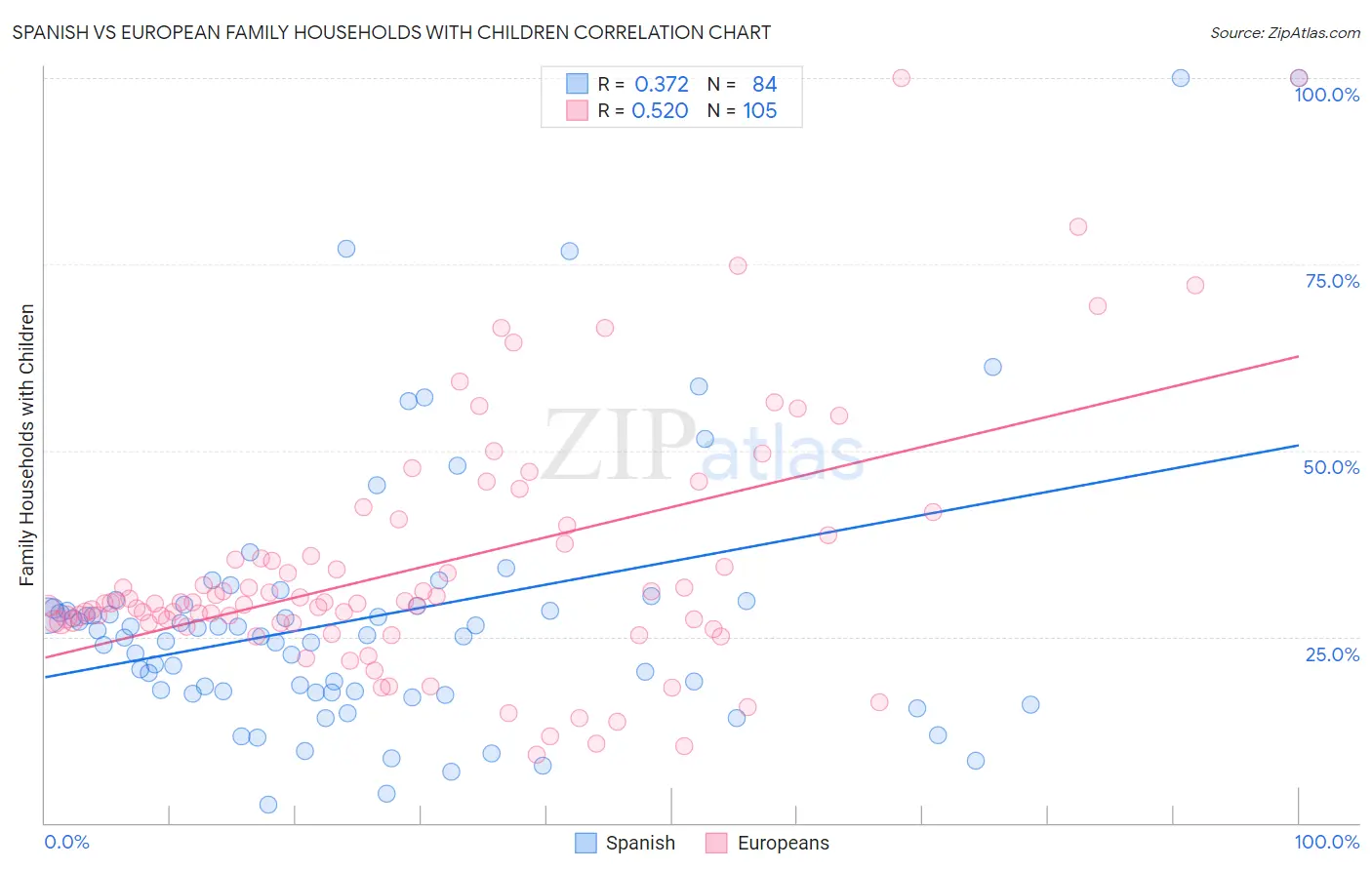Spanish vs European Family Households with Children
COMPARE
Spanish
European
Family Households with Children
Family Households with Children Comparison
Spanish
Europeans
27.7%
FAMILY HOUSEHOLDS WITH CHILDREN
81.8/ 100
METRIC RATING
140th/ 347
METRIC RANK
27.9%
FAMILY HOUSEHOLDS WITH CHILDREN
95.4/ 100
METRIC RATING
120th/ 347
METRIC RANK
Spanish vs European Family Households with Children Correlation Chart
The statistical analysis conducted on geographies consisting of 421,743,519 people shows a mild positive correlation between the proportion of Spanish and percentage of family households with children in the United States with a correlation coefficient (R) of 0.372 and weighted average of 27.7%. Similarly, the statistical analysis conducted on geographies consisting of 560,876,859 people shows a substantial positive correlation between the proportion of Europeans and percentage of family households with children in the United States with a correlation coefficient (R) of 0.520 and weighted average of 27.9%, a difference of 0.83%.

Family Households with Children Correlation Summary
| Measurement | Spanish | European |
| Minimum | 2.5% | 9.1% |
| Maximum | 100.0% | 100.0% |
| Range | 97.5% | 90.9% |
| Mean | 27.7% | 34.4% |
| Median | 25.1% | 29.6% |
| Interquartile 25% (IQ1) | 17.6% | 26.9% |
| Interquartile 75% (IQ3) | 29.2% | 38.0% |
| Interquartile Range (IQR) | 11.6% | 11.2% |
| Standard Deviation (Sample) | 18.1% | 16.9% |
| Standard Deviation (Population) | 18.0% | 16.8% |
Demographics Similar to Spanish and Europeans by Family Households with Children
In terms of family households with children, the demographic groups most similar to Spanish are Vietnamese (27.7%, a difference of 0.030%), Uruguayan (27.7%, a difference of 0.050%), Immigrants from Dominican Republic (27.7%, a difference of 0.080%), Immigrants from Portugal (27.7%, a difference of 0.090%), and Immigrants from Ecuador (27.7%, a difference of 0.11%). Similarly, the demographic groups most similar to Europeans are Immigrants from Western Asia (27.9%, a difference of 0.19%), Immigrants from Zimbabwe (27.8%, a difference of 0.26%), Immigrants from Northern Africa (27.8%, a difference of 0.33%), Immigrants from Singapore (27.8%, a difference of 0.40%), and Ecuadorian (27.8%, a difference of 0.40%).
| Demographics | Rating | Rank | Family Households with Children |
| Europeans | 95.4 /100 | #120 | Exceptional 27.9% |
| Immigrants | Western Asia | 93.6 /100 | #121 | Exceptional 27.9% |
| Immigrants | Zimbabwe | 92.8 /100 | #122 | Exceptional 27.8% |
| Immigrants | Northern Africa | 91.8 /100 | #123 | Exceptional 27.8% |
| Immigrants | Singapore | 90.8 /100 | #124 | Exceptional 27.8% |
| Ecuadorians | 90.8 /100 | #125 | Exceptional 27.8% |
| Immigrants | Ethiopia | 90.5 /100 | #126 | Exceptional 27.8% |
| Belizeans | 90.0 /100 | #127 | Exceptional 27.8% |
| Syrians | 89.7 /100 | #128 | Excellent 27.8% |
| Immigrants | Eritrea | 89.4 /100 | #129 | Excellent 27.8% |
| Cajuns | 87.6 /100 | #130 | Excellent 27.7% |
| Lebanese | 87.4 /100 | #131 | Excellent 27.7% |
| Immigrants | Belize | 85.7 /100 | #132 | Excellent 27.7% |
| Iranians | 85.2 /100 | #133 | Excellent 27.7% |
| Immigrants | Panama | 84.9 /100 | #134 | Excellent 27.7% |
| Immigrants | Ecuador | 84.6 /100 | #135 | Excellent 27.7% |
| Immigrants | Portugal | 84.1 /100 | #136 | Excellent 27.7% |
| Immigrants | Dominican Republic | 83.9 /100 | #137 | Excellent 27.7% |
| Uruguayans | 83.2 /100 | #138 | Excellent 27.7% |
| Vietnamese | 82.6 /100 | #139 | Excellent 27.7% |
| Spanish | 81.8 /100 | #140 | Excellent 27.7% |